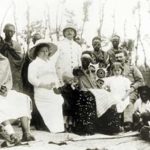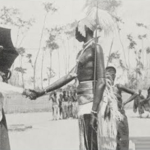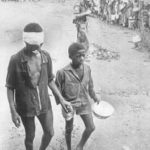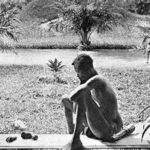Kinyagans And Cultural Identity
As the previous survey indicates, Kinyagan society in the mid-nineteenth century was heterogeneous, composed of both non-Rwadan and Rwandan elements. It is not clear to what extent this heterogeneity was reflected in the cultural identity of early immigrants. For example, before the nineteenth century there are no data indicating whether early pioneers coming from regions outside central Rwanda considered themselves “Rwandan” or wished to have close ties to the Rwandan court. Nor do we know to what extent these immigrants from the east and north distinguished themselves from the indigenous Kinyagan population or from immigrants coming from the west.
It is clear that stereotypes about people from the west (usually referred to indiscriminately as “Abashi”) are accepted now (and used in reference to the past) by Kinyagans who consider themselves as being of “Rwandan” background. Such stereotypes include ideas about food habits (Shi are despised for eating mutton, a meat which is thoroughly distasteful to most Rwandans), general social conduct (Shi are regarded as rude and uncultured, particularly in their public eating habits), ornamentation (Shi are said to have walked in public like “naked savages”; they filed their teeth), and language (Shi are thought to speak a tongue thoroughly laughable compared to the beauty of Ikinyarwanda). Many of these stereotypes are still vigorously applied today, especially by educated Rwandans, but we do not know to what extent they were important in Kinyaga before the introduction of central Rwandan control.”
For the nineteenth century, toward the end of Gahindiro’s reign (died in 1830) and during the reign of his son Rwogera (died in 1860), there are indications that identification with the central Rwandan court was growing. During this period the court made efforts to extend its influence into the region; early clientship to the royal court and membership in Rwandan social armies (umuheto groups) is often associated by informants with the time of Gahindiro and Rwogera. Understandably, such information on early linkages to the Rwandan court appears more often in the accounts of those who trace an origin for their ancestors to areas that are now Rwandan, and who consider their lineage to be of Tuutsi status.
Yet at least some immigrants from the west also began seeking ties to the Rwandan court in the nineteenth century, directly or through a Kinyagan intermediary of Rwandan culture. Even so, such action used as an assertion of cultural identity remained ambiguous, for many Kinyagans with origins in the west maintained commercial and social links with their home regions. Inhabitants of the peninsulas of Lake Kivu and the hills bordering the Rusizi River carried food, goats, and sometimes cattle to the west, exchanging these for fiber bracelets (ubutega) and hoes. Commercial ties were facilitated and reinforced by such social ties as blood brotherhood, friendship exchanges of cattle, and affinal kin relationships.
Some residents of Kinyaga began ta assert identity with the Rwandan central court during the nineteenth century; others apparently did not. But later, under Rwabugiri, the assertion of Rwandan identity became common among those who could trace links to areas that had been incorporated into the Rwandan state. People with close ties to the west felt divergent loyalties under Rwabugiri, and probably later as well. Some saw opportunities for status and security by asserting Rwandan identity; others cherished their links to the west, and although perhaps willing to acknowledge the political sovereignty of Rwanda, were reluctant to abandon their own culture. These divergent identities existed among different groups and sornetimes within the same individual. Over and above these sometimes conflicting loyalties, inhabitants of Kinyaga shared a common love of the autonomy they enjoyed before the reign of Rwabugiri.
Thus by the mid-nineteenth century at least some Kinyagans had links to the royal court or to central chiefs, and these links probably reflected sentiments of identification with Rwandan culture and the Rwandan king. It is not known how strong or widespread such identification was, but it seemed to be closely linked to a tradition of minimal interference by central authorities in local affairs. Loyalty to “Rwanda” initially involved few obligations but served as a source of local status.
https://uk.amateka.net/kinyagans-and-cultural-identity/https://uk.amateka.net/wp-content/uploads/2020/05/imiturire.jpghttps://uk.amateka.net/wp-content/uploads/2020/05/imiturire-150x150.jpgChanges and ColonialismAs the previous survey indicates, Kinyagan society in the mid-nineteenth century was heterogeneous, composed of both non-Rwadan and Rwandan elements. It is not clear to what extent this heterogeneity was reflected in the cultural identity of early immigrants. For example, before the nineteenth century there are no data indicating...BarataBarata rpierre@ikaze.netAdministratorAMATEKA | HISTORY OF RWANDA




